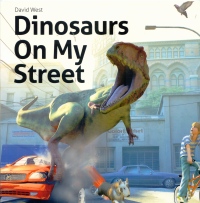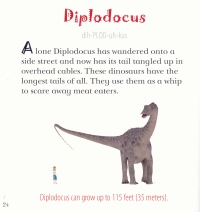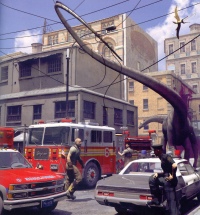| ________________
CM . . . . Volume XX Number 13 . . . . November 29, 2013
excerpt:
Over 20 years ago, author Michael Crichton introduced readers to Jurassic Park, a book in which dinosaurs, albeit cloned, co-existed with humans. That book became a film and then a film series, with the fourth installment, Jurassic World, now apparently scheduled to appear in the summer of 2015. Author/illustrator David West also uses the idea of dinosaurs sharing our streets as he alphabetically introduces 30 dinosaurs from Altirhinus to Zuniceratops. Each dinosaur is treated in a pair of facing pages with one page carrying the text and the other a full-colour computer artwork rendering of the dinosaur engaged in some activity on a city street.
While the book's intended young readers may have a vague idea of how tall a five-story high building is, does their imagined height match the page's concluding line which says, "Omeisaurus can grow up to 50 feet (15 meters)." The closing table reveals the Omeisaurus' height to be 30 feet or 9 meters.
A feature of the text page not yet described is the inclusion of a small illustration of the dinosaur that is inserted between the main text and the dinosaur's length line. In each case, a child is shown adjacent to the dinosaur, and this "comparison" placement provides readers with a visual reference as to size of each dinosaur. The idea was a very good one, but, unfortunately West devalued it by changing his "measuring stick" juvenile. Sometimes it's a young boy just standing next to the dinosaur, in other cases he's on his bicycle, and in yet other cases it's one of two different sized girls. The book closes with a table that appears on the last page and the inside of the back cover. The first column consists of the dinosaurs' names while the remaining six columns are labelled: Length, Height, Weight, Diet, When it lived, Found in. The dinosaurs' length, height and weight are presented in both Imperial and Metric units while "Diet" uses a symbol of a head of lettuce or a ham to indicate whether the dinosaur was a vegetarian or a carnivore. (Of the 30 dinosaurs presented, only Gigantoraptor appears to have been an omnivore.). The period during which each dinosaur lived is described in terms of the Jurassic and Cretaceous periods, with each being modified by "Early" or "Late". The periods are also "translated" into how many years ago that was. For example, the Early Jurassic period occurred some 205-180 million years ago, a span of time that will likely boggle the mind of the book's intended young readers. Finally, the "Found in" column, with one exception, uses the name of a contemporary country. For example, this column indicates that the Olorortitan once roamed in present day Russia while Suchominus used to hunt its prey in today's Niger. The computer generated artwork is quite effective. While the book has no plot, each illustration could be a prompt for its own mini-story, whether it's the four Velociraptors running off with a boy's soccer ball the quartet of dinosaurs have just, dog-like, stolen from a street game or the Tarbosaurus that is scavenging like an oversized racoon in some garbage cans. Though I have had a few quibbles with some aspects of the content of Dinosaurs on My Street, overall it is a most successful book that will appeal to those elementary grade children who just can't get enough dinosaur books. Highly Recommended. Dave Jenkinson, CM's editor, lives in dinosaur-free Winnipeg, MB.
To comment
on this title or this review, send mail to cm@umanitoba.ca.
Copyright © the Manitoba Library Association. Reproduction for personal
use is permitted only if this copyright notice is maintained. Any
other reproduction is prohibited without permission.
NEXT REVIEW |
TABLE OF CONTENTS FOR THIS ISSUE
- November 29, 2013.
AUTHORS |
TITLES |
MEDIA REVIEWS |
PROFILES |
BACK ISSUES |
SEARCH |
CMARCHIVE |
HOME |

 As the excerpt shows, the text begins by providing the dinosaur's name followed by the absolutely essential pronunciation guide to the tongue-twisting name of the dinosaur. A few brief sentences then describe what the dinosaur is doing as well as provide some factual information about it. The final text line for each dinosaur provides one of its dimensions in Imperial and Metric units. In the case of the Diplodocus above, readers are told that "Diplodocus can grow up to 115 feet (35 meters). However, is that the Diplodocus' height or its length? Answering that question becomes more difficult when one reads that "Deinonychus can grow up to 11 feet (3.5 meters) long." The addition of the word "long" could then make readers think that all of the other measurements were the dinosaurs' heights. A closing table, however, clarifies that these final text lines actually referred to the dinosaurs' lengths. I'm not certain why West chose not to present both the dinosaurs' length and height when they were first introduced since there were instances when a dinosaur's height was the more significant dimension, with one such case being the Omeisarus:
As the excerpt shows, the text begins by providing the dinosaur's name followed by the absolutely essential pronunciation guide to the tongue-twisting name of the dinosaur. A few brief sentences then describe what the dinosaur is doing as well as provide some factual information about it. The final text line for each dinosaur provides one of its dimensions in Imperial and Metric units. In the case of the Diplodocus above, readers are told that "Diplodocus can grow up to 115 feet (35 meters). However, is that the Diplodocus' height or its length? Answering that question becomes more difficult when one reads that "Deinonychus can grow up to 11 feet (3.5 meters) long." The addition of the word "long" could then make readers think that all of the other measurements were the dinosaurs' heights. A closing table, however, clarifies that these final text lines actually referred to the dinosaurs' lengths. I'm not certain why West chose not to present both the dinosaurs' length and height when they were first introduced since there were instances when a dinosaur's height was the more significant dimension, with one such case being the Omeisarus:
 The very brief text can only introduce a dinosaur, but sometimes that introduction raises a question that will remain unanswered unless the reader seeks some outside resources (and Dinosaurs on My Street lacks any list of references or a "For further reference" section). For instance, regarding the Microraptor, the reader sees, and is told, that "Three small dinosaurs glide past a child's window. They have leapt from a tree...." Readers might ask themselves, "If these four-winged dinosaurs are gliders, as opposed to flyers, how then do they get up high enough in a tree to be able to glide?" With regard to the Cryolophosaurus, readers are told it "comes from Antarctica and is not used to hot weather." Again, readers might wonder how dinosaurs existed in this continent of ice and snow as nothing in the text indicates that Cryolophosaurus lived in the Early Jurassic period, some 205-180 million years ago when Antarctica's climate was much different.
The very brief text can only introduce a dinosaur, but sometimes that introduction raises a question that will remain unanswered unless the reader seeks some outside resources (and Dinosaurs on My Street lacks any list of references or a "For further reference" section). For instance, regarding the Microraptor, the reader sees, and is told, that "Three small dinosaurs glide past a child's window. They have leapt from a tree...." Readers might ask themselves, "If these four-winged dinosaurs are gliders, as opposed to flyers, how then do they get up high enough in a tree to be able to glide?" With regard to the Cryolophosaurus, readers are told it "comes from Antarctica and is not used to hot weather." Again, readers might wonder how dinosaurs existed in this continent of ice and snow as nothing in the text indicates that Cryolophosaurus lived in the Early Jurassic period, some 205-180 million years ago when Antarctica's climate was much different.